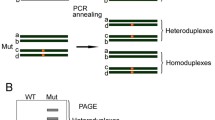Abstract
The apoptotic adapter protein FADD has been shown to play diverse roles in cell survival and proliferation. FADD knockout embryos died of heart defects, rendering Cre/loxP-mediated conditional FADD knockout mice a unique tool for investigating FADD-dependent nonapoptotic mechanism. Previously, these genetically engineered mice were identified by time-consuming Southern blot or controversial real-time PCR. In this article, we report a novel genotyping strategy based on allele-specific inverse PCR (ASI-PCR) for rapid and reliable identification of conditional FADD knockout mice. In this strategy, the knockout nature of FADD was simply identified by screening the absence of the wild type FADD-specific ASI-PCR product. Using this method, we accurately identified CD4-Cre-mediated T cell specific FADD knockout mice. The whole process can be accomplished in any normal biological laboratory within 12 h using genomic DNA from tail biopsy. The proposed ASI-PCR-based approach is simple, rapid, sensitive, reproducible, and especially suitable for genotyping small amount of spatiotemporally restricted biopsies and large animal population. We believe that the strategy described in this article may be of general utility in genotyping other conditional gene knockout mice.




Similar content being viewed by others
References
Strasser, A., & Newton, K. (1999). FADD/MORT1, a signal transducer that can promote cell death or cell growth. International Journal of Biochemistry and Cell Biology, 31, 533–537.
Krammer, P. H. (2000). CD95’s deadly mission in the immune system. Nature, 407, 789–795.
Muzio, M., Chinnaiyan, A. M., Kischkel, F. C., et al. (1996). Dixit, FLICE, a novel FADD-homologous ICE/CED-3-like protease, is recruited to the CD95 (Fas/APO-1) death-inducing signaling complex. Cell, 85, 817–827.
Vincenz, C., & Dixit, V. M. (1997). Fas-associated death domain protein interleukin-1beta-converting enzyme 2 (FLICE2), an ICE/Ced-3 homologue, is proximally involved in CD95- and p55-mediated death signaling. Journal of Biological Chemistry, 272, 6578–6583.
Muzio, M., Salvesen, G. S., & Dixit, V. M. (1997). FLICE induced apoptosis in a cell-free system. Journal of Biological Chemistry, 272, 2952–2956.
Muzio, M., Stockwell, B. R., Stennicke, H. R., et al. (1998). An induced proximity model for caspase-8 activation. Journal of Biological Chemistry, 273, 2926–2930.
Yeh, W. C., Pompa, J. L., McCurrach, M. E., et al. (1998). FADD: Essential for embryo development and signaling from some, but not all, inducers of apoptosis. Science, 279, 1954–1958.
Zhang, J., Cado, D., Chen, A., et al. (1998). Fas-mediated apoptosis and activation-induced T-cell proliferation are defective in mice lacking FADD/Mort1. Nature, 392, 296–300.
Kabra, N. H., Kang, C., Hsing, L. C., et al. (2001). T cell-specific FADD-deficient mice: FADD is required for early T cell development. Proceedings of the National Academy of Sciences of the United States of America, 98, 6307–6312.
Hueber, A. O., Zornig, M., Bernard, A. M., et al. (2000). A dominant negative Fas-associated death domain protein mutant inhibits proliferation and leads to impaired calcium mobilization in both T-cells and fibroblasts. Journal of Biological Chemistry, 275, 10453–10462.
Alappat, E. C., Volkland, J., & Peter, M. E. (2003). Cell cycle effects by C-FADD depend on its C-terminal phosphorylation site. Journal of Biological Chemistry, 278, 41585–41588.
Alappat, E. C., Feig, C., Boyerinas, B., et al. (2005). Phosphorylation of FADD at serine 194 by CKIalpha regulates its nonapoptotic activities. Molecular Cell, 19, 321–332.
Hua, Z. C., Sohn, S. J., & Kang, C. (2003). A function of Fas-associated death domain protein in cell cycle progression localized to a single amino acid at its C-terminal region. Immunity, 18, 513–521.
Zhang, Y., Rosenberg, S., Wang, H., et al. (2005). Conditional Fas-associated death domain protein (FADD): GFP knockout mice reveal FADD is dispensable in thymic development but essential in peripheral T cell homeostasis. Journal of Immunology, 175, 3033–3044.
Lee, P. P., Fitzpatrick, D. R., Beard, C., et al. (2001). A critical role for Dnmt1 and DNA methylation in T cell development, function, and survival. Immunity, 15, 763–774.
Sauer, B. (1998). Inducible gene targeting in mice using the Cre/lox system. Methods-A Companion to Methods in Enzymology, 14, 381–392.
Liu, P. T., Jenkins, N. A., & Copeland, N. G. (2002). Efficient Cre-loxP-induced mitotic recombination in mouse embryonic stem cells. Nature Genetics, 30, 66–72.
Bubner, B., & Baldwin, I. T. (2004). Use of real-time PCR for determining copy number and zygosity in transgenic plants. Plant Cell Reports, 23, 263–271.
Bubner, B., Gase, K., & Baldwin, I. T. (2004). Two-fold differences are the detection limit for determining transgene copy numbers in plants by real-time PCR. Bmc Biotechnology, 4, 14.
Foord, O. S., & Rose, E. A. (1994). Long-distance PCR. PCR Methods and Applications, 3, S149–S161.
Loukianov, E. V., Loukianova, T., & Periasamy, M. (1997). Identification of targeted embryonic stem cells using long-distance PCR. Biotechniques, 23, 376–378, 380.
Ochman, H., Gerbers, A. S., & Hartl, D. L. (1988). Genetic applications of an inverse polymerase chain reaction. Genetics, 120, 621–623.
Kobayashi, T., & Akane, A. (2000). ABO genotyping by inverse PCR technique. Legal Medicine (Tokyo), 2, 15–20.
Acknowledgments
This study is supported by the following funds to Zi-chun Hua from the Chinese National Nature Science Foundation (30330530, 30425009, and 30270291) and the Ministry of Education of China (SRFDP 20030284040). The authors are grateful to Dr. Astar Winoto (UC Berkeley, California, USA) for his generous providing of genetically modified mice.
Author information
Authors and Affiliations
Corresponding author
Rights and permissions
About this article
Cite this article
Dong, X., Li, J., Li, S. et al. A Novel Genotyping Strategy Based on Allele-specific Inverse PCR for Rapid and Reliable Identification of Conditional FADD Knockout Mice. Mol Biotechnol 38, 129–135 (2008). https://doi.org/10.1007/s12033-007-9002-y
Received:
Accepted:
Published:
Issue Date:
DOI: https://doi.org/10.1007/s12033-007-9002-y




